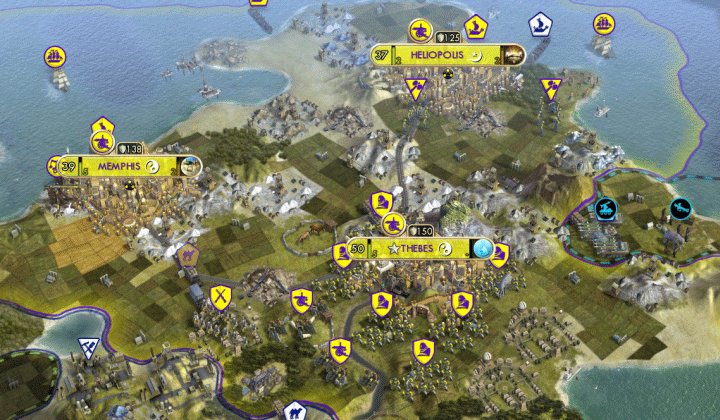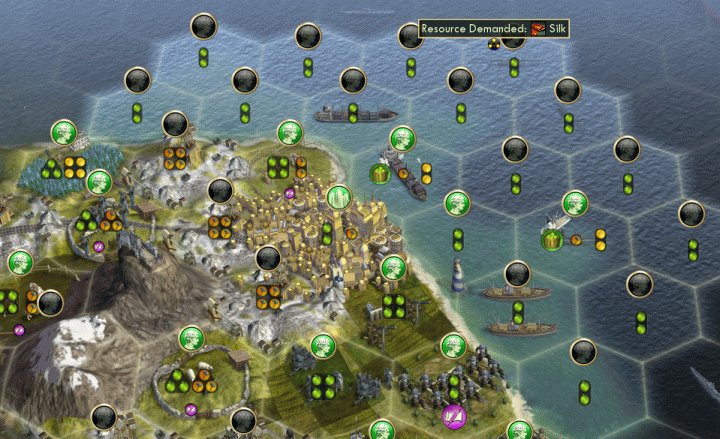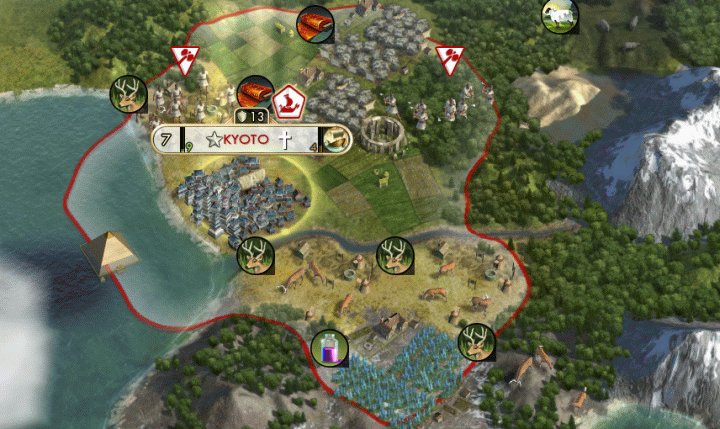Civ 5 Population and City Growth Guide
How Cities Grow - Tips and Strategies for Making Big Cities

Science, Gold, Production, and they are easier to Defend
Population Growth is key to keeping up in Civilization 5. It is the backbone of maximizing Science output and essential if you want to research technologies quickly. In Brave New World, we are given Trade Routes to help feed Citizens and make huge Cities. Putting together all the factors that contribute to city growth will allow you to have more Citizens in your empire. This Guide will teach you all about Food, Citizen Management, and the importance of having enough Workers.
How Cities Grow
Every point of Population comes from growth, which is created by excess Food. Cities working Tiles with 3+ food on them are going to grow and keep growing, up to the point they are 40+ Population so long as the focus is kept on growth. When you reach the Food requirement - which gets higher as the City gets bigger - you'll gain another Citizen to work Tiles and keep the process going. Each Citizen requires 2 Food, so if you were at the point that you had a 3-Population City and only 6 total Food coming from the tile the capital is on and three other tiles, you would stop growing (stagnant). Having 7 Food would make the City grow, but slowly, while 8-9 would make it grow much more rapidly.

Citizen Management
Key to growing your City is Citizen Management in the top right of all City Screens. The option to tweak focus is collapsed by default, so press the + sign on Citizen Management to access this feature. This allows you to micromanage the tiles your Citizens are working and lock them, so that the City works tiles that are important. Cities are able to work Tiles up to 3 Hexes away. Optimal City spacing is therefore 7 tiles away so that Cities do not overlap, however don't concern yourself if just a few overlap. Just be sure to lock the tiles that are shared on the City that is more important.
Micromanaging Tiles
Early in the game, Micromanagement of your Citizens is recommended to maximize growth while allowing Cities to continue to produce Buildings and Wonders. You are able to lock tiles to force a City to work them no matter the case - even to the point of starving a City. However, if you want it to grow, you'll want to focus on the Food tiles. Tiles with 3 Food are obvious for maximizing growth. Tiles with 2 Food, 1 Production are second in priority. This will let you make buildings. Your goal is to prevent the early City from working tiles with 1 Food, or something else that isn't even making up for what a Citizen eats. This will help it grow and keep up with the AI. Overall, go for Tiles with the most Food while prioritizing Production then Gold. When your City has grown enough, it will work the tiles with Production/Gold and allow you to start accumulating wealth and put out more Production.
Happiness is Essential
A new City requires 4 Happiness, as Cities cost a base of 3 and each unit of Population produces 1. To keep Cities growing, you must continually acquire more means of producing Happiness. I have a Civ 5 Happiness Guide that can help you with this. If a City is about to put your Civ into Unhappiness by growing and you don't have a new source about to come (a new Circus or connected Luxury) then click stop Growth under Citizen Management. Additionally, if your Capital is growing fast, you only have 1-2 Happiness, it has a National College and you are using Tradition, you should stop growth on all Cities to let the Capital consume the excess Happiness. Make Cities work on a building that produces Happiness immediately to allow ALL Cities to continue to grow. Ideally, you always have at least 5-6 Happiness to avoid needing to do this. Trade Deals with other Civs are key, as is discovery of Natural Wonders.
Settling Good Lands
With these things in mind, it's easier to spot good places to Settle. Areas with at least 2-3 Food Resources and a Luxury your Civ doesn't yet have are important. Rivers will give extra growth with Civil Service, giving +4 Food for a Grassland/River or Lake Tile. Rivers are better as they allow Hydro Plants for extra Production, boost Land Trade Route income, and allow for Gardens, which boost Great Person Generation by 25%. Settling lands like these allows you to easier use Specialists in Cities without sacrificing Growth. Getting there faster than the AI is important however, and you don't typically want to settle too close to another Civ's borders unless you can handle the Diplomatic Penalties. I try to get a Worker out after a Shrine/Scout and use my starting Warrior to defend that Worker. Then comes a Granary (usually) and Settler. The City is usually size 4 or 5 by then.
Building Settlers Fast
Cities stop growing when you build a Settler. You can chop forests to speed it up if you desire, but always put the City on Production Focus. This is important to mention here, though it's in several other areas in the Guide.

City Connections. Make at MINIMUM one Worker per City!
Minimum One Worker per City
Once you Settle a first City, your Capital should be capable of producing a Worker in 5 turns or less. Do this. Having 3 Workers for 2 Cities is GREAT. You can get one working on each City so that every tile worked is improved, and another can be working on establishing a City Connection. Once Cities are size six, City Connections pay off. You can get there within 40 Turns if you've settled in a good spot, while it takes some time to make a Road from 5-7 Tiles away. When you make another Settler, follow up with another Worker immediately. This helps immensely in getting a new City's terrain improved and will have a great impact on your Civilization as a whole.
Keep Cities Focused on Food
While there are times that it's necessary to switch to Production, say, when building a Wonder, the other 90% of the time your City should be on Food Focus - even to the point of making buildings take 10-15 Turns. You can put Cities on Food Focus while locking a few of the best Production/Gold Tiles to speed up construction a bit, while sacrificing some growth. If they're coming out in less than 10 turns, you're doing good. You will be able to buy Buildings with Gold so long as you use some of your Trade Routes for income, and not just Food. The question then comes to, "What to build?".
What to Build: Prioritizing Buildings for Growth
Buildings that give Food or affect growth should come first. The more Citizens you have, the higher your potential Production. The Granary is very important, as it allows you to send Food Trade Routes - but also if you have wheat, deer, or bananas near your City. If you started with Liberty, you also need Aqueducts as early as you can get them. The Aqueduct starts the City at 40% Food when it grows, meaning it speeds growth by about that much. These two buildings are very important, particularly if you choose Liberty for your opener (Policy choice).
Aside from those two, you always want to get Buildings that improve Tiles for you when you have 2 or more of that type of tile available. For example, Stables will give +1 Production on a Pasture. If you only have one, that can wait. If you have 3, it's a significant boost to the City and should be prioritized, because it will help you make future buildings faster. Windmills give +10% Production toward all Buildings. These will speed up the Production of everything you make in the future and give an Engineer slot that is very handy if the City has high food but low Production potential due to a lack of hills/forest. Lighthouses are very important if you have multiple Sea Resources nearby. They give extra Food and Production and are far more important than Fishing Boats.
Keep these concepts in mind as you go. Make Growth, Scientific, Production, and Gold buildings based on the City's terrain and the empire's current needs. Colosseums should go up as needed, which will work you toward a Circus Maximus an +5 Happiness. Late-Game Golden Ages are better than those in the early, for you'll make much more Culture, Gold, etc. simply by having more tiles with those attributes being worked. Make other Happiness buildings as needed, and always trade your excess resources for Happiness so that you do not need them right away. Markets are nearly useless if there are not many +Gold Tiles around the City, but are still important for letting you make the East India Company in your primary trading City.
These concepts ignore certain things like getting Opera Houses in all Cities for a Hermitage, but if you do things in the right order, you can boost a City's Production via Population and get ALL buildings up faster. In order to have high-population Cities, you'll simply HAVE to buy some buildings sometimes, else you spend too much time on Production Focus. Only do that for Wonders or really, really important buildings when you lack the Gold. If your Civ dips into Unhappiness, put all Cities on Production Focus so that they can get new Happiness buildings up faster, then switch back to Food Focus.
What to Research to Speed City Growth
While most players will go straight for Education and Scientific Theory with small diversions to pick up Luxuries, and techs like Construction, Banking, and others, you need some other Techs to maximize Growth. Thankfully, Civil Service, which boosts food from Farms next to Fresh Water sources like Lakes and Rivers is on the way to Education. Once you have Scientific Theory, you can go toward the bottom of the Tech Tree and run for Chemistry (more Production from Mines) and Fertilizer (+Food for Farms WITHOUT Fresh Water). Lighthouses (Optics Tech) are important in Coastal Cities to raise Food from open Coast tiles and Sea Resources. Later in the game, you can get extra Food from Hospitals (Biology Tech) and increase Food carryover after growth with Medical Labs (Penicillin Tech).
Offsetting Food Lost from Specialists with Food Trade Routes
With Sailing, Engineering, and Animal Husbandry, your Civilization will have access to 3 Trade Routes. Sending a Food Trade Route requires a Granary. One to two of these should always go to your Capital as it will typically have the National College while at the same time need to work Guilds for generation of Great Writers. With Universities, you have two more Specialist Slots to work to improve Science output. Throw in an Artist's Guild and the City then has SIX Citizens turned into Specialists, and the City will grow slowly while not producing buildings very well either. If it's coastal, a single Cargo Ship with Food can offset this problem and allow the Capital to grow. With Land, you need two Trade Routes carrying Food to the Capital. The third should go from the Capital to another Civilization to get Gold. This all depends on how many great Food tiles your Capital has available to work, while you must also pace growth in relation to available Happiness. Other Cities will be fine, as the only Specialist type they should be working in the early-mid game are those from Universities and Public Schools. They are only losing 3 Citizens from tiles while the Capital is losing 7-9 or more at that point. While on Food focus, your other Cities can continue to grow just fine until you unlock more Trade Routes with Banking and Compass.
Boosting a New City
All Trade Routes last 30 Turns and can't be cancelled. When you've just founded a new City, you can help it grow rapidly by sending a Food Trade Route from the Capital. When the 30 Turns are over, you can switch the Caravan or Cargo Ship's Home City to the original destination and start sending Food the other direction (to the Capital) for the above-mentioned reasons. Cities must be size 2 to make a Settler. If you do this right, and have the Workers to help with Production in a new City, you can have your Expansion City make your 2nd Settler while the Capital builds something important like the Hanging Gardens (if Tradition), Colossus for extra Trade Route, or some other thing you require like a Writer's Guild.
Later Trade Routes
When I want a Scientific Civ, which is important in nearly every Victory Condition in Civ 5, I typically only send a few of my external Trade Routes to other Civilizations. I like to have at least one going to each City (always choosing Cargo Ships if the City is Coastal) and two to the Capital. This will allow some Trade Routes to give Gold, while 4-5 are utilized by the Empire to carry Food. Your Cities growing will provide more money from City Connections, make them better targets for other Civs' Trade Routes (which give you income too) and allow them to work tiles that give Gold.
We Love the King Day
Knowing the Resources your Cities demand can help you produce several 'We Love the King' Day in any given game. So long as you pay attention by looking at the City Screen, you can trigger this bonus which grants 20% Growth to the City for 20 Turns. Look for Civs that have that Resource to trade, and offer them Gold for it if necessary. You can also see what Resources City-States offer and possibly ally with them to trigger this growth bonus. In my 50-Population Egyptian City in the screenshot above, I got a couple of these. Keeping the City on Food during that time is super-important to maximize usage of the bonus. When the celebration is over, the City will demand a new resource and you can start the process over. They always ask for something you don't yet have.
Starting Social Policy
Tradition will give a free Aqueduct in the first four Cities, along with massive Growth bonuses. These are HUGE. Overall, Tradition will make taller Cities than Liberty, but Liberty allows you to gobble up land quickly and have more Cities than Tradition. Overall, Tradition is viewed as the more powerful of the two for most games. If you find yourself on a big island that can easily hold 6+ Cities, go Liberty. Regardless of this, the information on this page is relevant to both. You want Cities to be as big as possible, and as far as buildings go, the main difference is the need to make Aqueducts and Monuments in your Cities. If you want to experiment with what you learned here, take Tradition and try to get, at minimum, 3 Cities, but preferably 4. You will need far less Military depending how friendly the AI is, and if you can avoid expanding too close to them.
Learning More
You can learn a lot more about the above concepts in the following strategy guides I've written for Civ 5:
- Cities - multi-page guide to managing Cities
- Happiness - essential to City Growth
- Trade Routes - Trade Route Income and Food/Production Trade Routes by Era
- Civ 5 Tips - General Civ 5 Gameplay Tips and Strategies
- Science - How Science is Determined & Researching Techs Faster
- Beginner's Guide - Early Game Help - Early-game Tips and Strategies for Beginners
Share your Tips
Share your Tips on growing a large City below to help your fellow Civ 5 players.
Share Tips and FAQs (3)
Our Sims Forum is the place to go for faster answers to questions and discussions about the game. Use the form below to share your own experiences and provide helpful tips to other readers.
 Reply
Reply Flag
Flag 5
5